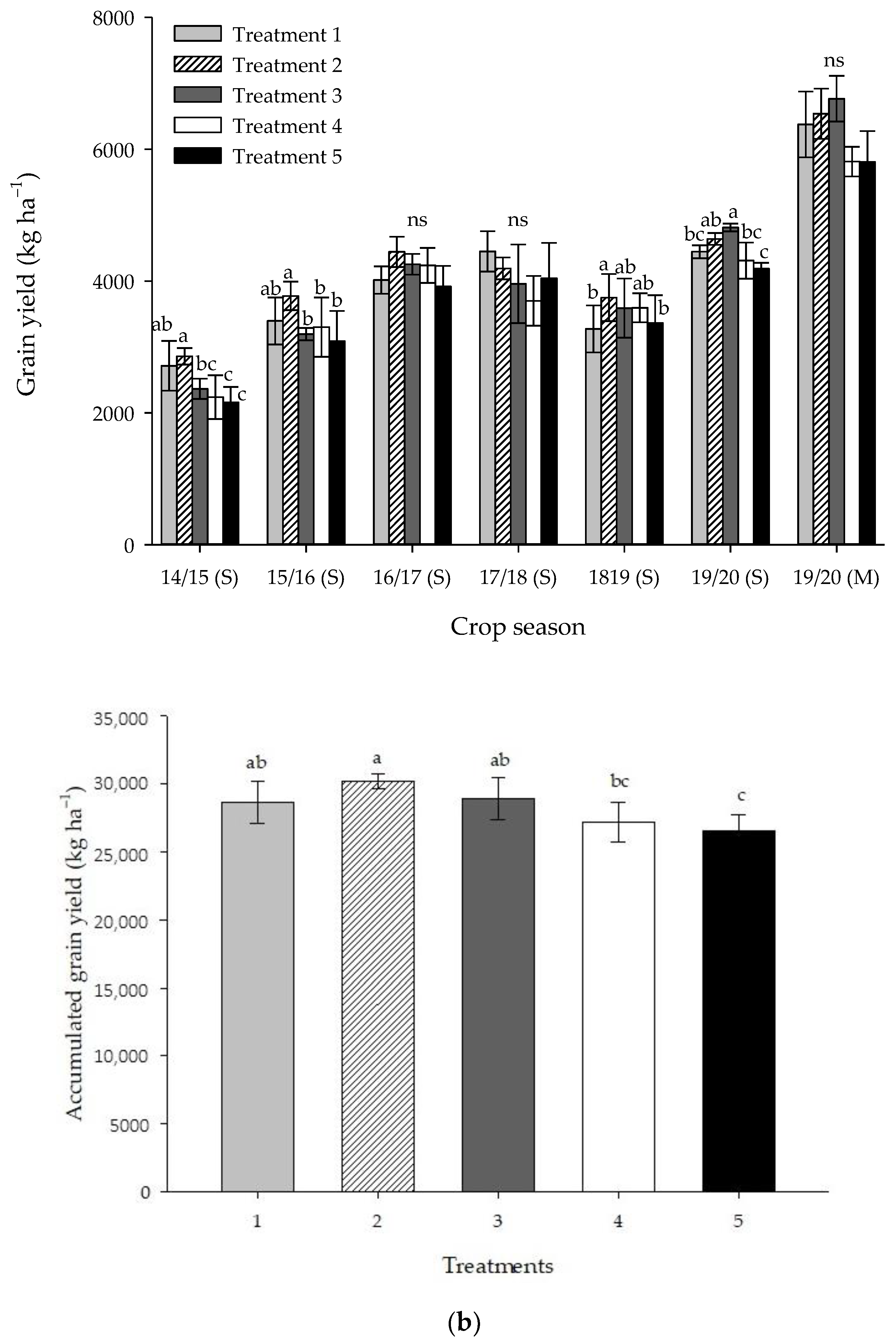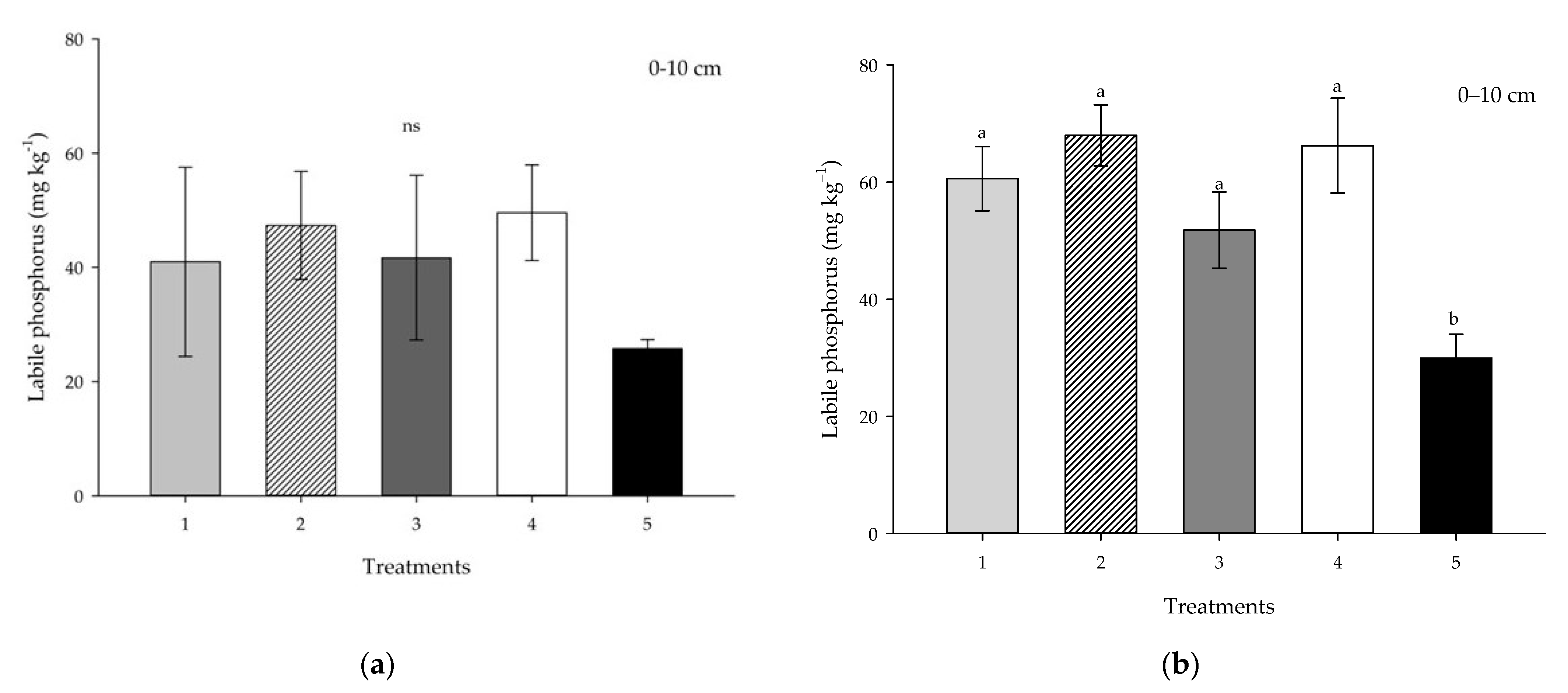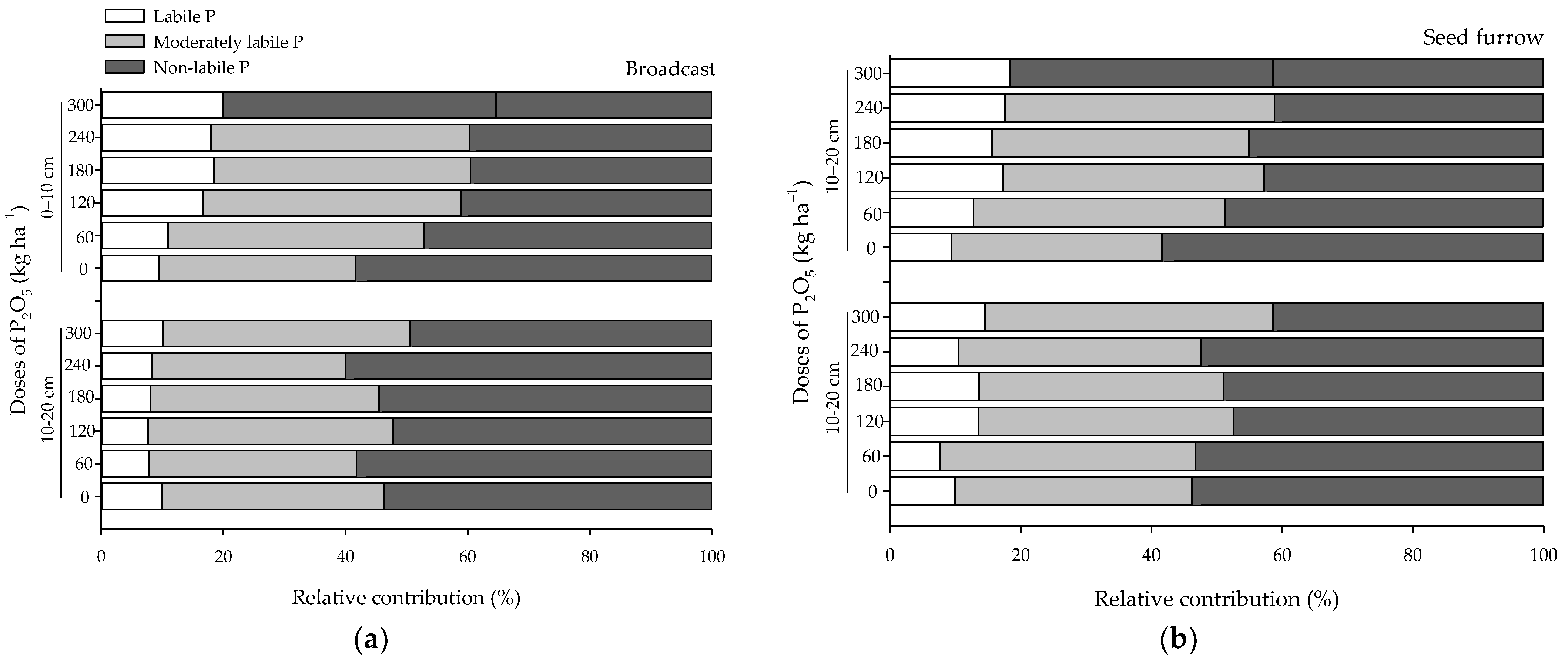Phosphate Management for High Soybean and Maize Yields in Expansion Areas of Brazilian Cerrado
Abstract
:1. Introduction
2. Materials and Methods
2.1. Experimental Area
2.2. Treatments
2.2.1. First Experiment—Phosphate Management for Soil P Buildup
2.2.2. Second Experiment—Response to P Doses
2.3. Crop and Soil Analysis
2.4. Data Analysis
3. Results and Discussion
3.1. Phosphate Management for Soil P Buildup
3.2. Phosphate Doses Response for Opening New Cultivated Areas
4. Conclusions
Supplementary Materials
Author Contributions
Funding
Data Availability Statement
Acknowledgments
Conflicts of Interest
References
- Lopes, A.S.; Guilherme, G. A career perspective on soil management in the Cerrado region of Brazil. Adv. Agron. 2016, 137, 1–72. [Google Scholar] [CrossRef]
- Dias, L.C.P.; Pimenta, F.M.; Santos, A.B.; Costa, M.H.; Ladle, R.J. Patterns of land use, extensification, and intensification of Brazilian agriculture. Glob. Chang. Biol. 2016, 22, 2887–2903. [Google Scholar] [CrossRef]
- Rodrigues, M.; Pavinato, P.S.; Withers, P.J.A.; Teles, A.P.B.; Herrera, W.F.B. Legacy phosphorus and no tillage agriculture in tropical oxisols of the Brazilian savanna. Sci. Total Environ. 2016, 542, 1050–1061. [Google Scholar] [CrossRef]
- Nunes, R.S.; Sousa, D.M.G.; Goedert, W.J.; Oliveira, L.E.Z.; Pavinato, P.S.; Pinheiro, T.D. Distribution of soil phosphorus fractions as a function of long-term soil tillage and phosphate fertilization management. Front. Earth Sci. 2020, 8, 350. [Google Scholar] [CrossRef]
- Pavinato, P.S.; Rocha, G.C.; Cherubin, M.R.; Harris, I.; Jones, D.L.; Withers, P.J.A. Map of total phosphorus content in native soils of Brazil. Sci. Agric. 2021, 78, 1–5. [Google Scholar] [CrossRef]
- Elser, J.J.; Elser, T.J.; Carpenter, S.R.; Brock, W.A. Regime shift in fertilizer commodities indicates more turbulence ahead for food security. PLoS ONE 2014, 9, 1–7. [Google Scholar] [CrossRef] [Green Version]
- Pavinato, P.S.; Cherubin, M.R.; Soltangheisi, A.; Rocha, G.C.; Chadwick, D.R.; Jones, D.L. Revealing soil legacy phosphorus to promote sustainable agriculture in Brazil. Sci. Rep. 2020, 10, 15615. [Google Scholar] [CrossRef]
- Coelho, M.J.A.; Ruiz Diaz, D.; Hettiarachchi, G.M.; Dubou Hansel, F.; Pavinato, P.S. Soil phosphorus fractions and legacy in a corn-soybean rotation on Mollisols in Kansas, USA. Geoderma Reg. 2019, 18, e00228. [Google Scholar] [CrossRef]
- Oliveira, L.E.Z.; Nunes, R.S.; Figueiredo, C.C.; Rein, T.A. Spatial distribution of soil phosphorus fractions in a clayey Oxisol submitted to long-term phosphate fertilization strategies. Geoderma. 2022, 418, 11–12. [Google Scholar] [CrossRef]
- Lopes, A.S. Solos Sob “Cerrado”: Características, Propriedades e Manejo; Potafos: Piracicaba, Brasil, 1996. [Google Scholar]
- Kurihara, C.H.; Silva, W.M.; Dias, M.M.; Tsujigushi, B.P.; Silva, J.V.S. Gradual correction of phosphorus availability in the no-tillage system. Rev. Ceres 2016, 63, 256–264. [Google Scholar] [CrossRef]
- Oliveira, L.E.Z.; Sousa, D.M.G.; Figueiredo, C.C.; Nunes, R.S.; Malaquias, J.V. Long-term phosphate fertilization strategies evaluation in a Brazilian Oxisol. Agron. J. 2020, 112, 4303–4320. [Google Scholar] [CrossRef]
- Hansel, F.D.; Ruiz Diaz, D.A.; Amado, T.J.C.; Rosso, L.H.M. Deep banding increases phosphorus removal by soybean grown under no-tillage production systems. Agron. J. 2017, 109, 1091–1098. [Google Scholar] [CrossRef] [Green Version]
- Oliveira, L.E.Z.; Nunes, R.S.; Sousa, D.M.G.; Busato, J.G.; Figueiredo, C.C. Response of maize to different soil residual phosphorus conditions. Agron. J. 2019, 3, 3291–3300. [Google Scholar] [CrossRef]
- Meena, D.; Prajapat, M.; Meena, B.; Dotaniya, C.K.; Meena, M.D. Phosphorus management strategies in sustainable agricultural system. Biotica Res. Today 2022, 4, 338–340. [Google Scholar]
- Hedley, M.J.; Stewart, J.W.B.; Chauhan, B.S. Changes in inorganic and organic soil phosphorus fractions induced by cultivation practices and by laboratory incubations. Sci. Soc. Am. J. 1982, 46, 970–976. [Google Scholar] [CrossRef]
- Coelho, M.J.A.; Ruiz-Diaz, D.; Rodrigues, M.; Ono, F.B.; Kappes, C.; Zancanaro, L.; Pavinato, P.S. Soil phosphorus fate and its lability after a long-term phosphorus fertilizer strategy in Brazilian Oxisol. Arch. Agron. Soil Sci. 2021, 67, 1694–1707. [Google Scholar] [CrossRef]
- Santos, H.G.; Jacomine, P.K.T.; Anjos, L.H.C.; Oliveira, V.Á.; Lumbreras, J.F.; Coelho, M.R.; Almeida, J.A.; Araújo Filho, J.C.; Oliveira, J.B.; Cunha, T.J.F. Sistema Brasileiro de Classificação de Solos, 5th ed.; Embrapa Solos: Brasília, Brasil, 2018; 355p. [Google Scholar]
- Soil Survey Staff. Soil Taxonomy: A Basic System of Soil Classification for Making and Interpreting Soil Survey, 2nd ed; Natural Resources Conservation Service: Washington, DC, USA, 1999; 886p.
- Ulzen, J.; Abaidoo, R.C.; Ewusi-Mensah, N. On-farm evaluation and determination of sources of variability of soybean response to Bradyrhizobium inoculation and phosphorus fertilizer in northern Ghana. Agric. Ecosyst. Environ. 2018, 267, 23–32. [Google Scholar] [CrossRef]
- Sousa, D.M.G.; Lobato, E. Cerrado: Correção do solo e Adubação; Embrapa Informação Tecnológica: Brasília, Brasil, 2004; 416p. [Google Scholar]
- Santos, D.R. Dinâmica do fósforo em sistemas de manejo de solos. Doutorado, Doutor em Ciência do Solo, Universidade Federal do Rio Grande do Sul, Porto Alegre, Brasil, 2000. [Google Scholar]
- Murphy, J.; Riley, J.P. A modified single solution method for the determination of phosphate in natural waters. Anal. Chim. Acta 1962, 27, 31–36. [Google Scholar] [CrossRef]
- Barrow, N.J.; Barman, P.; Debnath, A. Three Residual Benefits of Applying Phosphate Fertilizer. Soil Sci. Soc. Am. J. 2018, 82, 1168–1176. [Google Scholar] [CrossRef]
- Kurihara, C.H.; Silva, W.M.; Tsujigushi, B.P.; Silva, J.V.S.; Dias, M.M. Adubação Fosfatada no Sistema Plantio Direto; Embrapa Agropecuária Oeste: Dourados, Brasil, 2014; pp. 1–4. [Google Scholar]
- Oliveira, L.E.Z.; Nunes, R.S.; Sousa, D.M.G.; Figueiredo, C.C. Dynamics of residual phosphorus forms under diferente tillage systems in a Brazilian Oxisol. Geoderma 2020, 367, 1–13. [Google Scholar] [CrossRef]
- Moreira, A.; Sfredo, G.J.; Moraes, L.A.C.; Fageria, N.K.; Moreira, A.; Sfredo, G.J.; Moraes, L.A.C.; Fageria, N.K. Agronomic efficiency of two types of lime and phosphate fertilizer sources in Brazilian Cerrado soils cultivated with soybean. Commun. Soil Sci. Plant Anal. 2014, 45, 2319–2330. [Google Scholar] [CrossRef]
- Sousa, D.M.G.; Lobato, E. Adubação Fosfatada em Solos da Região do Cerrado; Potafos: Piracicaba, Brasil, 2003; 16p. [Google Scholar]
- Fageria, N.K.; Moreira, A.; Castro, C. Response of soybean to phosphorus fertilization in Brazilian Oxisol. Commun. Soil Sci. Plant Anal. 2011, 42, 2716–2723. [Google Scholar] [CrossRef]
- Carvalho, M.C.S.; Nascente, A.S.; Ferreira, G.B.; Mutadiua, C.A.P.; Denardin, J.E. Phosphorus and potassium fertilization increase common bean grain yield in Mozambique. Rev. Bras. Eng. Agric. Ambient 2018, 22, 308–314. [Google Scholar] [CrossRef] [Green Version]
- Mariussi, L.M.; Liete, R.C.; Fretas, G.A.; Leite, R.C.; Santos, A.C.M.; Carneiro, J.S.S.; Silva, R.R. Phosphate fertilization on soils with improved fertility in the Brazilian Cerrado. Agron. Colomb. 2019, 37, 39–46. [Google Scholar] [CrossRef]
- Rein, T.A.; Santos Junior, J.D.G.; Sousa, D.M.G.; Carvalho, W.P.; Lemes, G.C. Corrective and maintenance phosphorus fertilization on sugarcane yield in Oxisols. PAB Pesqui. Agropecuária Bras. 2020, 56, 1–10. [Google Scholar] [CrossRef]
- Mahmood, M.; Yi, T.; Qingxia, M.; Waqas, A.; Sajid, M.; Xiaoli, H.; Zhaohui, W. Changes in phosphorus fractions and its availability status in relation to long term P fertilization in loess plateau of China. Agronomy 2020, 10, 1818. [Google Scholar] [CrossRef]
- Rodrigues, M.; Withers, P.J.A.; Soltangheisi, A.; Vargas, V.; Holzschuh, M.; Pavinato, P.S. Tillage systems and cover crops affecting soil phosphorus bioavailability in Brazilian Cerrado Oxisols. Soil Tillage Res. 2021, 205, 104770. [Google Scholar] [CrossRef]
- Rigon, J.P.; Crusciol, C.A.; Calonego, J.C.; Pavinato, P.S.; Azevedo, A.C.; Rosolem, C.A. Intensive crop rotations and residue quality increase soil phosphorus lability under long-term no-till in tropical soils. Soil Tillage Res. 2022, 223, 105446. [Google Scholar] [CrossRef]
- Abdala, D.B.; Ghosh, A.K.; Silva, I.R.; Novais, R.F.; Venegas, V.H.A. Phosphorus saturation of a tropical soil and related P leaching caused by poultry litter addition. Agric. Ecosyst. Environ. 2012, 162, 15–23. [Google Scholar] [CrossRef]









| Layer | pH | H+Al | Ca | Mg | K | CEC 1 | P 2 | OM 3 | Clay | Silt | Sand |
|---|---|---|---|---|---|---|---|---|---|---|---|
| (cm) | CaCl2 | ---------mmolc dm−3-------- | mg dm−3 | --------g kg−1------- | |||||||
| 0–10 | 5.0 | 28.0 | 15.0 | 13.5 | 3.01 | 59.5 | 8.0 | 16.5 | 409 | 50 | 541 |
| 10–20 | 4.5 | 28.0 | 13.0 | 9.0 | 1.30 | 51.3 | 5.0 | 17.0 | 416 | 11 | 573 |
| P2O5 Application (kg ha−1) | Year | |||||
|---|---|---|---|---|---|---|
| 2014/15 | 2015/16 | 2016/17 | 2017/18 | 2018/19 | 2019/20 | |
| T1–T4 (1) | 144.0 + 98.0 (2) | 90.0 + 98.0 (2) | 54.0 + 98.0 (2) | 84.0 (3) | 84.0 (3) | 84.0 (3) |
| T5 (4) | 157.0 | 157.0 | 157.0 | 140.0 | 140.0 | 84.0 |
Disclaimer/Publisher’s Note: The statements, opinions and data contained in all publications are solely those of the individual author(s) and contributor(s) and not of MDPI and/or the editor(s). MDPI and/or the editor(s) disclaim responsibility for any injury to people or property resulting from any ideas, methods, instructions or products referred to in the content. |
© 2023 by the authors. Licensee MDPI, Basel, Switzerland. This article is an open access article distributed under the terms and conditions of the Creative Commons Attribution (CC BY) license (https://creativecommons.org/licenses/by/4.0/).
Share and Cite
Gotz, L.F.; Holzschuh, M.J.; Vargas, V.P.; Teles, A.P.B.; Martins, M.M.; Pavinato, P.S. Phosphate Management for High Soybean and Maize Yields in Expansion Areas of Brazilian Cerrado. Agronomy 2023, 13, 158. https://doi.org/10.3390/agronomy13010158
Gotz LF, Holzschuh MJ, Vargas VP, Teles APB, Martins MM, Pavinato PS. Phosphate Management for High Soybean and Maize Yields in Expansion Areas of Brazilian Cerrado. Agronomy. 2023; 13(1):158. https://doi.org/10.3390/agronomy13010158
Chicago/Turabian StyleGotz, Lenir Fátima, Marquel J. Holzschuh, Vitor P. Vargas, Ana Paula B. Teles, Mayara M. Martins, and Paulo Sergio Pavinato. 2023. "Phosphate Management for High Soybean and Maize Yields in Expansion Areas of Brazilian Cerrado" Agronomy 13, no. 1: 158. https://doi.org/10.3390/agronomy13010158





